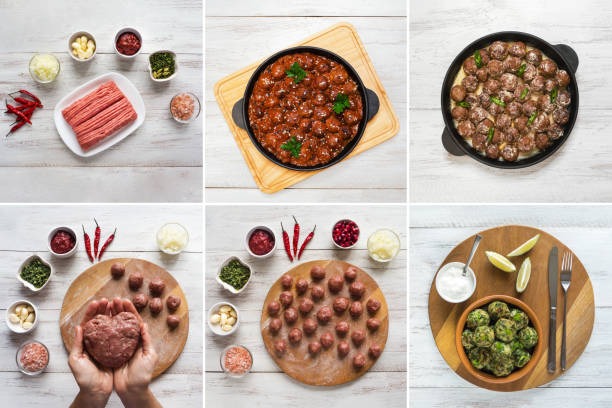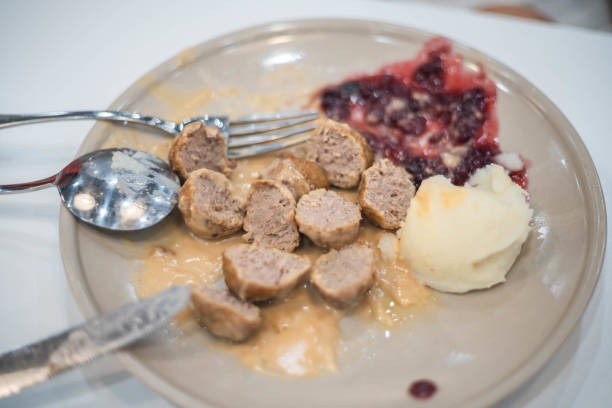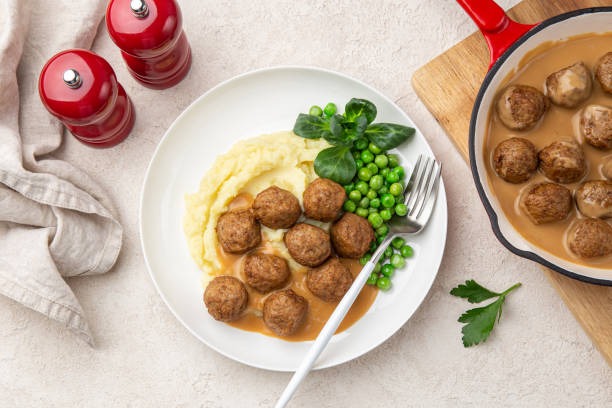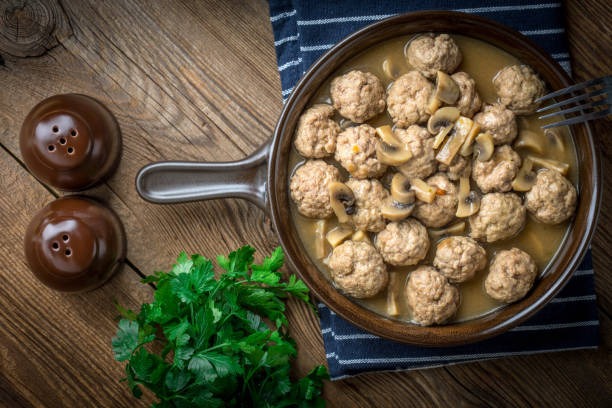There’s something magical about the aroma of Swedish meatballs simmering in creamy gravy that instantly transports you to a cozy Stockholm kitchen. I still remember my first authentic köttbullar experience at my Swedish friend’s grandmother’s house—tender, perfectly spiced meatballs that melted in my mouth, accompanied by that iconic cream sauce that dreams are made of.
Swedish meatballs aren’t just food; they’re a cultural phenomenon that has conquered hearts worldwide. From IKEA’s cafeterias to fine dining establishments, these humble spheres of seasoned ground meat have become synonymous with comfort food excellence. But what separates truly exceptional Swedish meatballs from the mediocre ones you might encounter?
The secret lies in understanding the delicate balance of ingredients, mastering traditional techniques, and respecting the cultural heritage behind this beloved dish. Unlike Italian meatballs that often feature herbs like basil and oregano, or Greek keftedes with their Mediterranean flair, Swedish meatballs rely on subtle spices like allspice and nutmeg to create their distinctive flavor profile.
This comprehensive guide will transform your kitchen into a Swedish culinary haven. You’ll discover the authentic ingredients that make köttbullar special, master the step-by-step techniques that ensure perfect results every time, and learn the cultural stories that make each bite more meaningful. Whether you’re a complete beginner or an experienced cook looking to refine your skills, you’ll walk away with the knowledge to create Swedish meatballs that would make any Swedish grandmother proud.
The Essential Ingredients for Authentic Swedish Meatballs
Creating exceptional Swedish meatballs starts with selecting the right ingredients. Each component plays a crucial role in achieving that distinctive taste and texture that makes köttbullar so beloved. After testing countless combinations over the years, I’ve learned that authenticity comes from understanding why each ingredient matters.
Choosing Your Ground Meat Blend
The foundation of great Swedish meatballs lies in the meat selection. Traditional recipes call for a combination of ground beef and pork, typically in a 50-50 ratio. The beef provides structure and robust flavor, while the pork adds essential fat content and tenderness. Some regions prefer a three-meat blend, adding veal for extra delicacy.
Ground beef should have about 20% fat content—lean meat will result in dry, tough meatballs. When selecting pork, opt for shoulder or a mix that includes some fatty portions. I’ve found that asking your butcher to grind the meat fresh makes a noticeable difference in both flavor and texture.
The Role of Breadcrumbs and Dairy
Fine, dry breadcrumbs act as both a binder and moisture absorber in Swedish meatballs. They prevent the mixture from becoming too wet while helping maintain the meatballs’ shape during cooking. Panko breadcrumbs work well, but traditional fine breadcrumbs create a more authentic texture.
The dairy component—either heavy cream or whole milk—is what gives Swedish meatballs their characteristic tenderness. The liquid is typically mixed with breadcrumbs first, creating a paste called a panade. This technique, borrowed from French cuisine, ensures even moisture distribution throughout the meat mixture.
Spice Blend That Defines Swedish Flavor
What truly distinguishes Swedish meatballs from their international cousins is the spice combination. Ground allspice is the star ingredient, providing that warm, slightly sweet flavor that’s unmistakably Swedish. Freshly grated nutmeg adds complexity, while white pepper contributes subtle heat without overpowering the delicate meat flavors.
Many recipes include finely minced yellow onion, either raw or lightly sautéed. I prefer sautéing the onion until translucent—this extra step mellows the sharpness and adds sweetness. Garlic can be included but should be used sparingly to maintain the traditional flavor profile.
Step-by-Step Recipe for Perfect Swedish Meatballs

Mastering Swedish meatballs requires attention to detail and patience. This foolproof method has been refined through countless kitchen experiments and feedback from Swedish friends who’ve shared their family secrets. The key is treating each step with care rather than rushing through the process.
Preparing the Meat Mixture
Start by combining your breadcrumbs with cream in a large mixing bowl. Let this mixture sit for 5-10 minutes until the breadcrumbs fully absorb the liquid. This panade will keep your meatballs incredibly moist and tender throughout the cooking process.
Add your ground meat, beaten egg, minced onion, and spices to the bowl. Here’s where many home cooks make their biggest mistake—overmixing. Use your hands to gently combine ingredients until just incorporated. The mixture should hold together when squeezed but still feel light and airy.
Forming Perfect Meatballs
Traditional Swedish meatballs are smaller than their Italian counterparts, typically about 1 to 1.5 inches in diameter. Keep a bowl of cold water nearby to wet your hands—this prevents sticking and creates smoother meatballs. Roll each portion gently between your palms, applying just enough pressure to form a cohesive sphere.
Consistency is crucial for even cooking. I use a small ice cream scoop or cookie scoop to portion the meat mixture, ensuring each meatball is identical in size. This professional technique guarantees that all meatballs finish cooking simultaneously.
Mastering the Cooking Process
Heat butter and a splash of oil in a large, heavy-bottomed skillet over medium heat. The oil prevents butter from burning while maintaining that rich, buttery flavor essential to authentic Swedish meatballs. Don’t overcrowd the pan—cook in batches if necessary.
Brown the meatballs on all sides, turning them carefully with tongs or a spoon. This process takes about 8-10 minutes total. The goal is achieving a beautiful golden-brown crust while keeping the interior juicy. Remove browned meatballs to a plate while you prepare the gravy.
Creating the Signature Cream Gravy
The creamy gravy, or gräddsås, is what elevates Swedish meatballs from good to extraordinary. Using the same pan with all those delicious browned bits, create a roux by whisking butter and flour together over medium heat. Cook for 2-3 minutes to eliminate the raw flour taste.
Gradually whisk in beef or chicken broth, ensuring no lumps form. The mixture will thicken as it heats. Once smooth, slowly add heavy cream while continuing to whisk. Season with salt, white pepper, and a pinch of nutmeg. Return the meatballs to the gravy and simmer gently for 10-15 minutes.
Professional Tips for Swedish Meatball Success
After years of perfecting this recipe, I’ve discovered several game-changing techniques that separate restaurant-quality results from home cooking disasters. These insider tips come from professional chefs, Swedish grandmothers, and my own trial-and-error experiences in the kitchen.
Temperature Control Is Everything
Use a meat thermometer to ensure your meatballs reach an internal temperature of 165°F (74°C). This eliminates guesswork and prevents both undercooking and overcooking. Undercooked meatballs pose health risks, while overcooked ones become dry and crumbly despite your best efforts with the meat mixture.
Keep your meat mixture cold until ready to form meatballs. Some chefs even chill the formed meatballs for 30 minutes before cooking. This firms up the mixture, making them easier to handle and helping them hold their shape better during the browning process.
The Art of Gentle Handling
Resist the urge to press down on meatballs with your spatula while cooking. This squeezes out precious juices and creates dense, tough results. Similarly, avoid moving them too frequently—let each side develop a proper crust before turning.
When testing for doneness, gently press the center of a meatball. It should feel firm but still have slight give. Meatballs continue cooking in the hot gravy, so slightly underdone at this stage is perfect.
Gravy Consistency Secrets
The perfect Swedish meatball gravy should coat the back of a spoon without being too thick or thin. If your gravy becomes too thick, whisk in additional broth gradually. If it’s too thin, create a slurry with equal parts flour and cold water, then whisk it into the simmering gravy.
Strain your gravy through a fine-mesh sieve for restaurant-quality smoothness. This extra step removes any lumps and creates that velvety texture that makes people wonder about your secret technique.
Creative Variations on Traditional Swedish Meatballs

While respecting tradition is important, there’s room for creativity within the Swedish meatball framework. These variations cater to different dietary needs and flavor preferences while maintaining the essential character that makes köttbullar special.
Plant-Based Swedish Meatballs
Modern Swedish cuisine embraces plant-based alternatives that capture the traditional flavors. Combine equal parts finely chopped mushrooms, walnuts, and cooked lentils as your base. Add the same seasonings—allspice, nutmeg, white pepper—along with breadcrumbs and a flax egg for binding.
The key to successful vegetarian Swedish meatballs lies in achieving the right texture. Pulse ingredients in a food processor until they hold together but aren’t completely smooth. Pan-fry these plant-based versions in the same manner, though they may need gentler handling during cooking.
Gluten-Free Adaptations
Replace traditional breadcrumbs with gluten-free alternatives like crushed rice crackers, almond flour, or certified gluten-free breadcrumbs. The cooking process remains identical, though you may need to adjust the liquid ratios slightly depending on your chosen substitute.
For the gravy, substitute all-purpose flour with rice flour or a gluten-free flour blend. Whisk thoroughly to prevent lumps, and remember that some gluten-free flours require longer cooking times to eliminate any gritty texture.
International Fusion Approaches
While purists might object, adding subtle international influences can create exciting variations. A hint of fresh dill brings Scandinavian freshness, while a small amount of Dijon mustard in the gravy adds French sophistication. These additions should complement, not overpower, the traditional Swedish flavor profile.
Some contemporary Swedish chefs incorporate ingredients like lingonberry powder directly into the meat mixture or add a splash of aquavit to the gravy for extra Nordic character.
Serving Swedish Meatballs Like a Pro
Presentation and accompaniments can transform your homemade Swedish meatballs from a simple dinner into a memorable dining experience. Traditional serving methods have evolved over generations, creating both classic and contemporary approaches to this beloved dish.

Classic Accompaniments
Traditional Swedish meatballs are served alongside buttery mashed potatoes, tart lingonberry jam, and crisp pickled cucumber. The mashed potatoes should be creamy and smooth—the perfect vehicle for soaking up that incredible gravy. Use Yukon Gold potatoes for the best texture and flavor.
Lingonberry jam provides essential acidity that cuts through the rich cream sauce. If lingonberries aren’t available, cranberry sauce makes an acceptable substitute, though the flavor profile will be slightly different. The pickled cucumber adds freshness and crunch that balances the meal’s richness.
Modern Presentation Ideas
Contemporary serving styles include arranging meatballs over egg noodles, serving them as appetizers with toothpicks, or creating a Swedish meatball bowl with roasted vegetables and grains. These modern approaches maintain the dish’s essential character while adapting to current dining trends.
For entertaining, consider serving Swedish meatballs from a slow cooker or warming tray. This keeps them at the perfect temperature while allowing guests to serve themselves. Provide small plates and cocktail napkins for easy mingling.
Wine and Beverage Pairings
Traditional Swedish beverages include aquavit or beer, but wine pairings can elevate the dining experience. Choose wines that complement rather than compete with the creamy, spiced flavors. A crisp Riesling or Gewürztraminer works beautifully, as does a light Pinot Noir.
For non-alcoholic options, consider sparkling water with lingonberry or elderflower, traditional Swedish drinks that cleanse the palate between bites.
Nutritional Profile and Health Considerations
Understanding the nutritional aspects of Swedish meatballs helps you make informed decisions about portion sizes and modifications. While this comfort food isn’t typically considered health food, there are ways to optimize its nutritional profile without sacrificing taste.
Macronutrient Breakdown
Traditional Swedish meatballs are protein-rich, with each serving providing approximately 25-30 grams of high-quality protein. The fat content varies depending on your meat choices and cooking methods, typically ranging from 15-25 grams per serving. Carbohydrates are minimal, primarily from breadcrumbs and the gravy’s flour content.
The cream sauce significantly impacts the caloric content. Each serving of traditional gravy adds approximately 150-200 calories, mostly from dairy fat. However, this fat provides satiety and helps with the absorption of fat-soluble vitamins.
Making Healthier Modifications
Reduce calories by using a combination of ground turkey and lean beef instead of traditional beef and pork. Greek yogurt can partially replace heavy cream in the gravy, though this changes the flavor slightly. Baking instead of pan-frying eliminates some cooking fat while still achieving good results.
Increase vegetable content by finely mincing carrots or zucchini into the meat mixture. These additions boost fiber and nutrients while maintaining the traditional texture and flavor profile.
Portion Control Strategies
Swedish meatballs are rich and satisfying, so proper portion control is important. A typical serving consists of 4-6 meatballs with gravy. Bulk up the meal with vegetables and salad rather than increasing meatball portions.
Consider serving Swedish meatballs as part of a larger meal with multiple small portions rather than making them the sole focus. This traditional Swedish approach allows you to enjoy the flavors while maintaining nutritional balance.
The Cultural Legacy of Swedish Meatballs

Swedish meatballs represent more than just a delicious meal—they’re cultural ambassadors that have introduced millions of people worldwide to Swedish cuisine. Understanding this cultural context adds depth to your appreciation of this beloved dish.
IKEA’s Global Impact
IKEA’s decision to serve Swedish meatballs in their cafeterias has arguably done more to spread Swedish cuisine globally than any other single factor. Over 150 million portions are served annually across IKEA stores worldwide. While these may not represent the pinnacle of Swedish cooking, they’ve created curiosity about authentic Swedish cuisine.
The company’s recipe differs from traditional home cooking methods, optimized for large-scale production. However, IKEA has also released their recipe publicly, allowing home cooks to recreate their version alongside more traditional approaches.
Swedish Holiday Traditions
In Sweden, meatballs play important roles in holiday celebrations, particularly during Christmas and Midsummer festivals. They’re often part of smörgåsbord spreads, served alongside other traditional dishes like pickled herring, gravlax, and various salads.
Swedish families often have their own secret variations passed down through generations. These family recipes represent cultural heritage and personal identity, making each version special to those who grew up with specific flavor memories.
Modern Swedish Cuisine Evolution
Contemporary Swedish chefs continue evolving meatball traditions while respecting their roots. Restaurants like Stockholm’s Pelikan serve elevated versions using premium ingredients and modern techniques. These interpretations prove that traditional foods can evolve without losing their essential character.
The New Nordic cuisine movement has also influenced meatball preparation, with chefs incorporating foraged ingredients, sustainable meat sources, and modern presentation styles while maintaining traditional flavor profiles.
People Also Ask About Swedish Meatballs
What makes Swedish meatballs different from Italian meatballs?
Swedish meatballs are typically smaller and use different seasonings, particularly allspice and nutmeg instead of Italian herbs. They’re always served with cream gravy, while Italian meatballs are usually served with tomato-based sauces. The meat mixture often includes cream or milk for extra tenderness.
Can you freeze Swedish meatballs?
Yes, Swedish meatballs freeze excellently for up to three months. Freeze them after cooking but before adding to gravy. Thaw overnight in the refrigerator, then reheat gently in fresh gravy. You can also freeze the complete dish, though the gravy texture may change slightly upon reheating.
What’s the origin of Swedish meatballs?
Contrary to popular belief, Swedish meatballs may have originated from a recipe brought to Sweden by King Charles XII in the early 18th century, possibly influenced by Turkish cuisine. However, they’ve been thoroughly adapted to Swedish tastes and ingredients over centuries, making them authentically Swedish regardless of their origins.
What vegetables pair well with Swedish meatballs?
Traditional accompaniments include pickled cucumber and steamed vegetables like carrots, green beans, or Brussels sprouts. Roasted root vegetables like parsnips and turnips also complement the rich flavors. Avoid strongly flavored vegetables that might compete with the delicate spicing.
How do you prevent Swedish meatballs from falling apart?
Don’t overmix the meat mixture, ensure your breadcrumb-to-liquid ratio is correct, and let the mixture rest before forming meatballs. Use gentle hands when shaping, and don’t move them too quickly while cooking. A properly balanced mixture with adequate binding ingredients should hold together well.
Creating Memorable Swedish Meatball Experiences
The journey to mastering Swedish meatballs extends far beyond following a recipe—it’s about understanding the cultural heritage, respecting traditional techniques, and adapting them to create memorable experiences in your own kitchen. The techniques and insights shared in this guide represent years of experimentation, cultural learning, and passionate cooking.
Remember that perfection comes with practice. Your first batch might not match your expectations, but each attempt teaches valuable lessons about meat handling, seasoning balance, and cooking techniques. The most important ingredient in any Swedish meatball recipe is patience—both with the cooking process and with yourself as you develop these skills.
Swedish meatballs offer something special in our fast-paced world: they require presence, attention, and care. The act of forming each meatball by hand, carefully monitoring the browning process, and slowly building the perfect gravy creates a meditative cooking experience that’s as rewarding as the final result.
Whether you’re cooking for family dinner, entertaining friends, or simply satisfying your own craving for comfort food, these techniques will serve you well. Share your creations, experiment with the variations, and most importantly, enjoy the process of bringing a piece of Swedish culinary tradition into your home kitchen.
Meta data
Meta title
Best Swedish Meatballs Recipe: Authentic Köttbullar Guide
Meta description
Master authentic Swedish meatballs with our complete guide. Learn traditional techniques, secret tips, and variations for perfect köttbullar every time.

